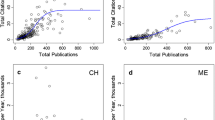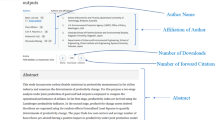Abstract
In any academic discipline, published articles in respective journals represent “production units” of scientific knowledge, and bibliometric distributions reflect the patterns in such outputs across authors or “producers.” Closely following the analysis approach used for similar studies in the economics and finance literature, we present the first study to examine whether there exists an empirical regularity in the bibliometric patterns of research productivity in the business ethics literature. Our results present strong evidence that there indeed exists a distinct empirical regularity. It is the so-called Generalized Lotka’s Law of scientific productivity pattern: the number of authors publishing n papers is about 1/n c of those publishing one paper. We discuss the likely processes that underlie the productivity pattern postulated by the Generalized Lotka’s Law. We find that the value of the exponent c is equal to about 2.6 for the comprehensive bibliometric data across the two leading business ethics journals. The observed research productivity pattern in the business ethics area, a relatively young discipline, is interestingly very consistent with those found in much older, related business disciplines like economics, accounting, and finance. We discuss the general implications of our findings.
Similar content being viewed by others
References
Akerlof, G. A.: 1970, ‘The Market for “Lemons”: Quality Uncertainty and the Market Mechanism’, The Quarterly Journal of Economics, 84 (3), 488-500.
Allison, P. D. and J. A. Stewart: 1974, ‘Productivity Differences Among Scientists: Evidence for Accumulative Advantage’, American Sociological Review, 39, 596-606.
Andriani, P. and B. McKelvey: 2009, ‘From Gaussian to Paretian Thinking: Causes and Implications of Power Laws in Organizations’, Organization Science, 20, 1053-1071.
Bettencourt, L.M.A., J. Lobo, D. Helbing, C. Kühnert and G. B. West: 2007, ‘Growth, innovation, and the pace of life in cities’, Proceedings of the National Academy of Sciences, 104, 7301–7306.
Bino, P. G. D., S. Sasidharan and R. Ananthakrishnan: 2005, ‘Concentration in Knowledge Output: A Case of Economics Journals’, European Journal of Comparative Economics, 2(2), 261-279.
Bookstein, A.: 1977, ‘Patterns of Scientific Productivity and Social Change: A Discussion of Lotka’s Law and Bibliometric Symmetry’, Journal of the American Society for Information Science, 28(4), 206-210.
Boyd, B. K., S. Finkelstein and S. Gove: 2005, ‘How Advanced is the Strategy Paradigm? The Role of Particularism and Universalism in Shaping research Outcomes’, Strategic Management Journal 26, 841-854.
Chung, K. H. and R. A. K. Cox: 1990, ‘Patterns of Productivity in the Finance Literature: A Study of the Bibliometric Distributions’, Journal of Finance, 45, 301-309.
Chung, K. H., H. S. Pak and R. A. K. Cox: 1992, ‘Patterns of Research Output in the Accounting Literature: A Study of the Bibliometric Distributions’, Abacus, 28(2), 168-185.
Chung, K. H. and R. Puelz: 1992, ‘An Empirical Regularity in the Market for Risk and Insurance Research Output’, Journal of Risk & Insurance, 59(3), 489-498.
Coile, R.: 1977, ‘Lotka’s Frequency Distribution of Scientific Productivity’, Journal of the American Society for Information Science, 28(6), 366-370.
Cole J. R. and S. Cole: 1973, ‘Social Stratification in Science’, Chicago: University of Chicago Press.
Cox, R. A. K. and K. H. Chung: 1991, ‘Patterns of Research Output and Author Concentrations in the Economics Literature’, Review of Economics and Statistics, 73, 729-733.
Dean, P. J.: 1997, ‘Examining the Profession and the Practice of Business Ethics’, Journal of Business Ethics, 16, 1637-1649.
DiPrete, T. A. and G. M. Eirich: 2006, ‘Cumulative Advantage as a Mechanism for Inequality: A Review of Theoretical and Empirical Developments’, Annual Review of Sociology, 32, 271-297.
Feller, W.: 1968, ‘An Introduction to Probability Theory and Its Applications’, New York: John Wiley and Sons.
Friedman, M.: 1966, ‘The Methodology of Positive Economics’, Essays In Positive Economics, Chicago: Univ. of Chicago Press.
Gabaix, X.: 1999, ‘Zipf’s law for cities: An explanation’, The Quarterly Journal of Economics, 114, 739–767.
Gans J.S. and G. B. Shepherd: 1994, ‘How Are the Mighty Fallen: Rejected Classic Articles by Leading Economists’, Journal of Economic Perspectives, 8, 165-179.
Grove, W. and S. Wu: 2007, ‘The Search for Economics Talent: Doctoral Completion and Research Productivity’, American Economic Review, 97, 506-511.
Gupta, B., L. Sharma and S. Kumar: 1998, ‘Literature growth and author productivity patterns in Indian Physics’. Information Processing & Management, 34(1), 121.
Hodgson G. M. and H. Rothman: 1999, ‘The Editors and Authors of Economics Journals: A Case of Institutional Oligopoly’, Economic Journal, 109, 165-186.
Holbrook, M.B.: 1986, ‘A Note on Sadomasochism in the Review Process: I Hate when that Happens’, Journal of Marketing, 50, 104-106.
Huber, J.: 1998, ‘The underlying process generating Lotka’s law and the statistics of exceedances’, Information Processing & Management, 34(4), 471.
Huber, J.: 2002, ‘A New Model that Generates Lotka’s Law’, Journal of the American Society for Information Science & Technology, 53(3), 209–0.
Kahn, W. A.: 1990, ‘Toward an Agenda for Business Ethics Research’, Academy of Management Review, 15(2), 311-328.
Karen, P.: 2004, ‘Business and Society and Business Ethics Journals: A Citation and Impact Analysis’, Journal of Scholarly Publishing, 35(2), 103-117.
Koenig, M. and T. Harrell: 1995, ‘Lotka’s Law, Price’s Urn, and Electronic Publishing’, Journal of the American Society for Information Science, 46(5), 386-388.
Laband D. and M. Piette: 1994, ‘Favouritism versus Search for Good Papers: Empirical Evidence Regarding the Behaviour of Journal editors’, Journal of Political Economy, 102, 194-203.
Lotka, A. J.: 1926, ‘The frequency distribution of scientific productivity’, Journal of the Washington Academy of Sciences, 16, 317-323.
Lovell M. C.: 1973, ‘The Production of Economic Literature: An Interpretation’, Journal of Economic Literature, 11, 27-55.
Mandelbrot, B.: 1954, ‘Simple games of strategy occurring in communication through natural languages’, I.R.E. Transactions on Information Theory, 3, 124-137.
Merton, R.K.: 1973, ‘The Mathew Effect in Science’, in ‘The Sociology of Science’, edited by N. W. Storer, Chicago: University of Chicago Press.
Mittal, V., L. Feick and F. Murshed: 2008, ‘Publish and Prosper: The Financial Impact of Publishing by Marketing Faculty’, Marketing Science, 27(3), 430-442.
Morris, S. and M. Goldstein: 2007, ‘Manifestation of research teams in journal literature: A growth model of papers, authors, collaboration, coauthorship, weak ties, and Lotka’s law’, Journal of the American Society for Information Science & Technology, 58(12), 1764-1782.
Murphy, L.: 1973, ‘Lotka’s Law in the Humanities’, Journal of the American Society for Information Science, 24(6), 461-462.
Price, D. S.: 1976, ‘A general tbeory of bibliometric and other cumulative advantage processes’, Journal of the American Society for Information Science 27, 292-306.
Radhakrishnan, T. and R. Kernizan: 1979, ‘Lotka’s Law and Computer Science Literature’, Journal of the American Society for Information Science, 30(1), 51-54.
Rainer, R. K. and M. D. Miller: 2005, ‘Examining Differences across Journal Rankings’, Communications of the ACM, 48(2), 91-94.
Randall, D. M. and A. M. Gibson: 1990, ‘Methodology in Business Ethics Research: A Review and Critical Assessment’, Journal of Business Ethics, 9(6), 457-471.
Robertson, C. J.: 2008, ‘An Analysis of 10 years of Business Ethics Research in Strategic Management Journal: 1996-2005’, Journal of Business Ethics, 80, 745-753.
Rodgers, R. and N. Rodgers: 1999, ‘The Sacred Spark of Academic Research’, Journal of Public Administration Research and Theory, 9(3), 473-492.
Sabrine, M.: 2002, ‘A Ranking of the Most Productive Business Ethics Scholars: A Five-Year Study’, Journal of Business Ethics, 36, 355-379.
Schorr, A. E.: 1974, ‘Lotka’s Law and library science’, Reference Quarterly, 14, 32-33.
Schorr, A. E.: 1975, ‘Lotka’s Law and map librarianship’, Journal of the American Society for Information Science, 26(3), 189-190.
Simon, H. A.: 1955, ‘On a class of skew distribution functions’, Biometrika, 42, 425-440.
Solla, P. D.: 1976, ‘A General Theory of Bibliometric and Other Cumulative Advantage Processes’, Journal of the American Society for Information Science, 27(5/6), 292-306.
Stigler G. J., S. M. Stigler and C. Friedland: 1995, ‘The Journals of Economics’, Journal of Political Economy, 103, 331-359.
Strogatz, S.: 2009, Math and the City. The New York Times, May 19.
Subramanyam, K.: 1979, ‘Lotka’s Law and the literature of computer science’, IEEE Transactions on Professional Communication PC, 22, 187-189.
Swanson, E.P., C. J. Wolfe and A. Zardkoohi: 2007, ‘Concentration in Publishing at Top-Tier Business Journals: Evidence and Potential Explanations’, Contemporary Accounting Research, 24, 1255-1289.
Tseng, H. C., C. H. Duan, H. L. Tung and H. J. Kung: 2010, ‘Modern Business Ethics Research: Concepts, Theories, and Relationships’, Journal of Business Ethics, 91(4), 587-597.
Voos, H.: 1974, ‘Lotka and information science’, Journal of the American Society for Information Science, 25, 270-272.
Waples, E. P., A. L. Antes, S. T. Murphy, S. Connelly and M. D. Mumford: 2009, ‘A Meta-Analytic Investigation of Business Ethics Instruction’, Journal of Business Ethics, 87, 133-151.
Whitfield, J.: 2006, ‘In the Beat of a Heart: Life, Energy, and the Unity of Nature’, Joseph Henry Press, Washington DC.
Wicks, A. C. and R. Derry 1996, ‘An Evaluation of Journal Quality: The Perspectives of Business Ethics Researchers’, Business Ethics Quarterly, 6(3): 359-371.
Worthen, D. B.: 1978, ‘Short-lived technical literatures: A bibliometric analysis’, Methods of Information in Medicine, 17, 190-198.
Wry, T. E.: 2009, ‘Does Business and Society Scholarship Mater to Society? Pursuing a Normative Agenda with Critical Realism and Neoinsitutional Theory’, Journal of Business Ethics, 89, 151-171.
Zivney, T. L. and W. J. Bertin: 1992, ‘Publish or Perish: What the Competition is Really Doing’, Journal of Finance, 47(1), 295-329.
Author information
Authors and Affiliations
Corresponding author
Rights and permissions
About this article
Cite this article
Talukdar, D. Patterns of Research Productivity in the Business Ethics Literature: Insights from Analyses of Bibliometric Distributions. J Bus Ethics 98, 137–151 (2011). https://doi.org/10.1007/s10551-010-0539-5
Published:
Issue Date:
DOI: https://doi.org/10.1007/s10551-010-0539-5




